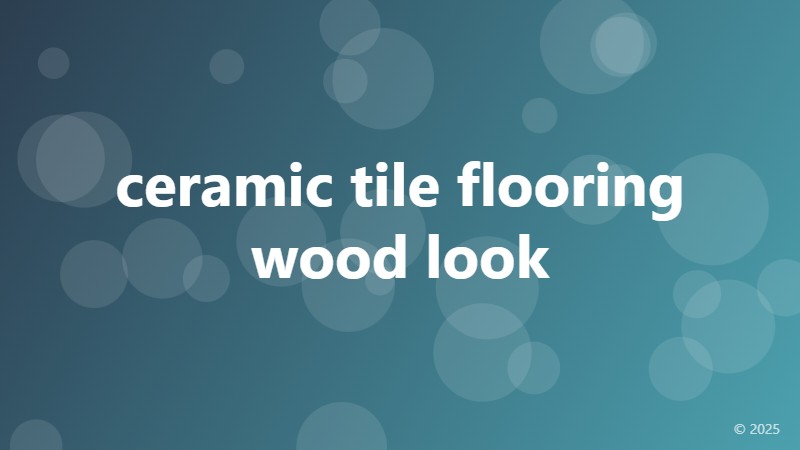ceramic tile flooring wood look

The Ultimate Guide to Ceramic Tile Flooring with a Wood Look
Ceramic tile flooring with a wood look has become increasingly popular in recent years, and for good reason. It offers the durability and low maintenance of ceramic tiles, while mimicking the natural beauty of wood flooring. In this article, we'll delve into the benefits, types, and installation process of ceramic tile flooring with a wood look, as well as provide some tips for choosing the perfect tile for your space.
Benefits of Ceramic Tile Flooring with a Wood Look
One of the primary advantages of ceramic tile flooring with a wood look is its durability. Unlike natural wood flooring, ceramic tiles are resistant to scratches, dents, and fading, making them perfect for high-traffic areas. Additionally, ceramic tiles are easy to clean and maintain, requiring only a damp mop to keep them looking their best.
Another benefit of ceramic tile flooring with a wood look is its versatility. With advancements in technology, ceramic tiles can now be designed to mimic the look of various types of wood, from oak to walnut. This means that homeowners can achieve the look of wood flooring without the hefty price tag or maintenance requirements.
Types of Ceramic Tile Flooring with a Wood Look
There are several types of ceramic tile flooring with a wood look to choose from, each with its own unique characteristics and benefits. Some of the most popular options include:
Glazed Ceramic Tiles: These tiles feature a glazed surface that is resistant to scratches and fading, making them perfect for high-traffic areas.
Porcelain Tiles: Porcelain tiles are known for their durability and resistance to moisture, making them ideal for areas prone to water exposure, such as bathrooms and kitchens.
Ceramic Wood Plank Tiles: These tiles are designed to mimic the look of natural wood planks, with a rectangular shape and realistic wood grain patterns.
Installation Process
The installation process for ceramic tile flooring with a wood look is similar to that of traditional ceramic tiles. However, there are a few key considerations to keep in mind:
Subfloor Preparation: The subfloor must be level, clean, and dry before installation can begin. Any cracks or unevenness must be addressed to ensure a smooth and even surface.
Tile Layout: The tile layout should be carefully planned to ensure a natural, random pattern. This can be achieved by using a combination of rectangular and square tiles.
Grouting and Sealing: After the tiles are installed, the grout lines should be sealed to protect them from stains and moisture.
Tips for Choosing the Perfect Ceramic Tile Flooring with a Wood Look
When choosing the perfect ceramic tile flooring with a wood look, there are a few key factors to consider:
Color and Pattern: Choose a tile that complements the color scheme and style of your home. Consider the natural wood look you're trying to achieve and choose a tile that accurately mimics it.
Size and Shape: Consider the size and shape of the tile in relation to the room. Larger tiles can make a small room appear larger, while smaller tiles can create a more intimate atmosphere.
Quality and Durability: Choose a tile that is high-quality and durable, with a reputation for withstanding heavy foot traffic and moisture exposure.
By considering these factors and following the tips outlined above, you can create a beautiful and functional ceramic tile flooring with a wood look that will last for years to come.